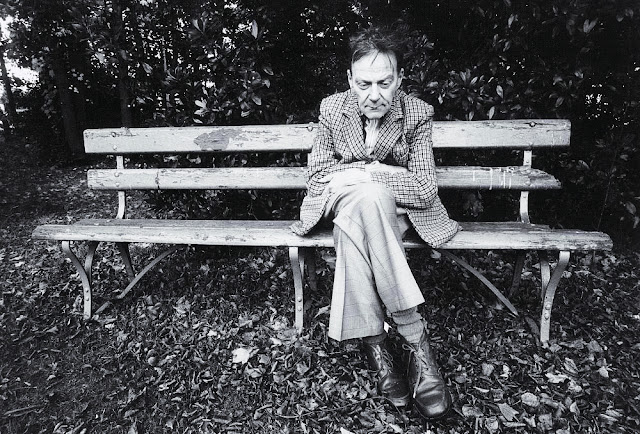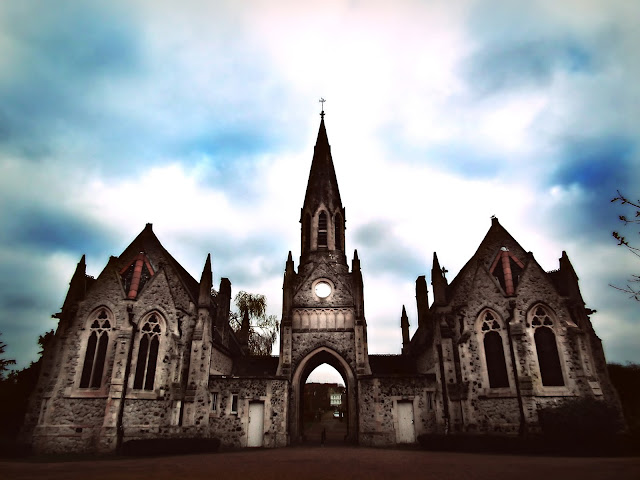In the
observation ward of Claybury Hospital
I read the Coming
of the Bill.
Ivan
Blatný - Nastoupit v rad
 |
| A portrait of Blatny taken at Ipswich in the late 1980's by Jerry Bauer |
The
35 year old Ivan Blatný was admitted as a long term patient in 1954to Claybury Asylum in Woodford Bridge. The prematurely middle-aged Czech with the strong mittel-European
accent was in poor physical as well as mental health. He was thin, frail and undernourished, had a serious chest infection and was limping from an untreated
ingrown toenail. The psychiatrist who admitted him noted that the poet had been
brought into the hospital by friends on whose floor he had been sleeping for
the past few months. He had been making a precarious living for two or three
years working for the BBC World Service and Radio Free Europe and publishing a
few verses in an anthology of poets in exile. His homesickness and natural
timidity kept him isolated and he only mixed in the émigré community. As a
result of this and despite a natural facility for languages (he knew Esperanto,
German, Italian and Spanish as well as Czech) after six years in England his
spoken English still wasn’t fluent. It wasn’t his first stay in a mental
hospital – the doctor would have seen from his records that he had been
originally admitted to Friern-Barnet in 1948 and transferred later that same
year to Claybury. When the door of the ward closed behind him it was to be for
the last time, Ivan Blatný was never to live outside an institution again. He
spent the next 36 years living at Claybury and other hospitals in Essex and
East Anglia.
 |
| The three year Ivan Blatny |
Ivan
was born in Brno in 1919 and came from an artistic background. He was
precociously intellectual and by the age of 9 he was entering into literary
contests and was learning Esperanto and German and travelling across Europe
with his parents. In 1930, when he was eleven, his father became ill with a
pulmonary infection that was eventually diagnosed as tuberculosis and died
shortly afterwards. The family were left in straitened circumstances but coped
until three years later when Ivan’s mother contacted hepatitis and also died.
The devastated Ivan moved in with his maternal grandparents and poured out his
feelings in verse. He later attended the Faculty of Arts at Masaryk University
reading Czech and German, for a few months in 1939 before the Nazi Reich Protectorate
closed down all places of higher learning.
With nothing better to do Ivan took over his grandfather’s opticians
business in the centre of Brno. For the next 6 years he devoted himself to
myopia, astigmatism and poetry. He contributed regularly to magazines and
published works written in collaboration with the Bohemian Jewish poet Jirí
Orten as well as three collections of his own poems. Jirí Orten was Ivan’s best
friend but on his 22 birthday, the 30th August 1941, he left his apartment in
Prague to buy cigarettes and was knocked down by a German ambulance. He was refused admission to the first
hospital he was taken too because he was Jewish and died two days later. The
stress of living under Nazism led to Ivan’s first breakdown for which he was
hospitalised briefly. In 1946 Ivan joined the Communist Party of
Czechoslovakia.
 |
| Claybury Hospital, Woodford Bridge |
In
March 1948 the poet had a stroke of luck when he was offered a place on a three
man cultural delegation from the Czech Writer’s Syndicate to London. He
defected the moment he arrived in the UK, resigning his membership in the
Communist Party and his place in the Writer’s Syndicate and sending his
membership papers back to the respective organisations in the post. On the day
after his arrival he turned a talk he was scheduled to give on the Czech
service of BBC radio into a denunciation of the Communist authorities. The Czech authorities were furious and
reacted by declaring him a traitor, banning his work and confiscating his
property in Brno.
 |
| Blatny in Brno as a young man |
Within a few months of his defection the
stress of living as a refugee and the virulence of the Czech authorities
reaction led to another breakdown. For
the next six years he was in and out of hospital; during periods of remission
he worked sporadically as an External co-worker for the BBC World Service and
Radio Free Europe, learnt Spanish and Italian and continued to write poetry.
But by 1954 when he was admitted to Claybury for the last time his illness
conspired to rob him of his poetic gift. He fell into a 15 year silence that
was to last until the late sixties. The young writer seemed to be totally
forgotten, his work banned in his homeland where many believed him to be dead
anyway, doubly locked away from the world, inside a profoundly disruptive
mental illness and inside the asylum, terrified of KGB spies amongst his
friends and acquaintances in the émigré community. His isolation seemed
complete. But at least one group of people still remembered him and still took
a keen interest in is welfare. When the archives of the Czech state security
services were opened following the velvet revolution there was a substantial
file on Blatný (codename NEWT) which included a top secret plan to bring him
back to Czechoslovakia. A Major Kolarik was to visit Blatný at Claybury and try
to entice him home. The visit was not a success; Major Kolarick informed the
Security Services that the poet was "in fact insane".
Following
this visit even the Czech State Security Services lost interest in him. For the
next eleven years Blatný lived quietly at Claybury with no contact with the
outside world. In February 1969 he received his first visitor from
Czechoslovakia since Major Kolarik. His cousin, Dr. Jan Šmarda had succeeded in
tracing him and visited him in secret. In June he received another visitor from
his hometown, a high school teacher, Vladimír Bařina. Bařina was an admirer of
Blatný’s work who brought news from Brno, greetings from some of his old
friends and poems from Klement Bochořák. The visit and the interest shown in
his poetry seems to have stimulated him to start writing again.
Over
the next eight years he wrote continuously, both in Czech and English and
guarded his manuscript’s jealously in a cardboard box. The hospital staff still
regarded his work as the scribblings of a lunatic and threw them away if they
were given the opportunity. This work would no doubt have all been lost in time
if Blatný had not been transferred in January 1977 to St Clement’s Hospital in
Ipswich. A nurse working at the hospital, Frances Meacham, visited Brno later
that year to stay with a friend who had served with her in the RAF medical
corps during the Second World War.
During her visit she met, by complete coincidence, Vladimír Bařina who
also introduced her to Jan Šmarda. The pair begged her to take care of Blatný
and to keep them informed of how the poet was. With this began an extraordinary
collaboration between the nurse and the patient that lasted until Blatný’s
death in 1990.
Frances
Meacham encouraged Blatný to put together a collection of his writings and she
sent these to the famous Czech novelist Josef Skvorecky in Toronto. In 1979
these were published as Stara Bydliste (Former Homes) by the Skvorecky’s famous
émigré publishing house 68. This was his first book for 32 years. Its success encouraged Ivan to put together
another book almost immediately which was published as samizdat in
Czechslovakia in 1982 and then again by the Skvorecky’s in 1987. Pomocná s˘kola
Bixley, Bixley Special School, was Blatný’s most unusual work, written almost as
much in English as in Czech with the odd dash of German, French and Esperanto.
 |
| Blatny with Frances Meacham, 1980's |
Blatný
published no more after Pomocná s˘kola Bixley. In 1990 Vaclav Havel paid his
first official visit to the UK. Frances Meacham presented him with a letter
from Blatný offering him his congratulations and informing him that he will
remain in Britain. Five months later he became seriously ill with emphysema and
on the 5th August he died in Colchester General Hospital. Later that day the Czechoslovak ambassador
announced that Blatný was considered to be a Czechoslovak citizen at the time
of his death. Following the cremation of his body his ashes were flown back to
Brno and, in an official ceremony, they were placed alongside his father’s in
the Central Cemetery. Father and son rested side by side for the first time in
60 years.
On
the 28th October 1997 Vaclav Havel announced that the Za zasluhy medal for
merit would be awarded to Ivan Blatný in memoriam, “for outstanding artistic
work.”
























